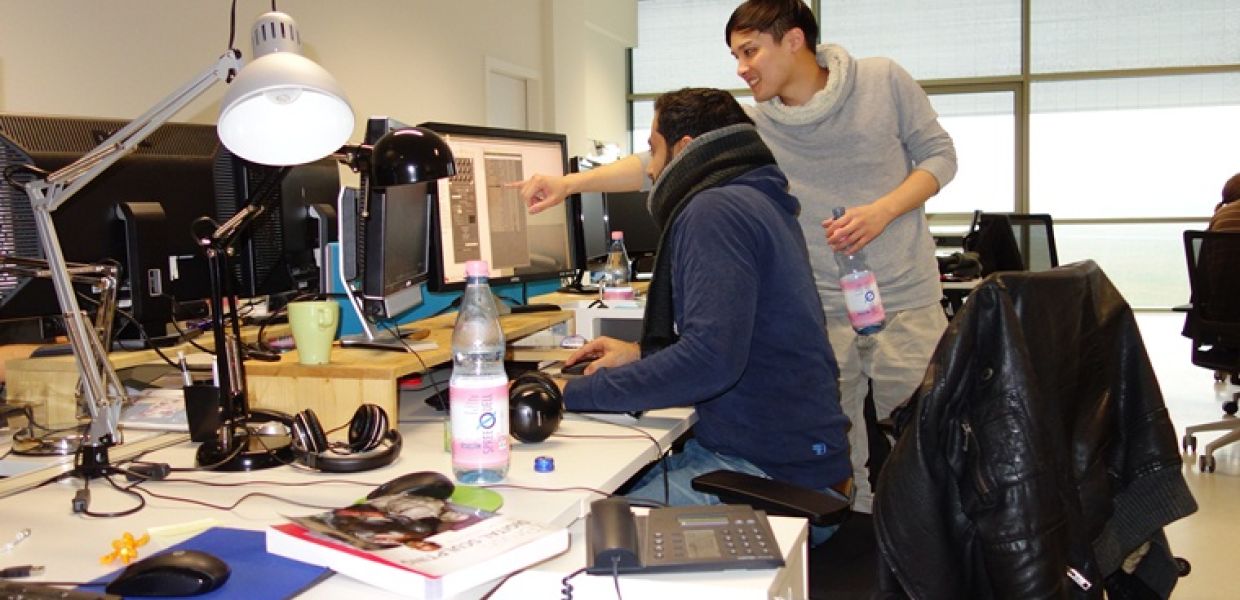Introducing Exozet Games

An interview with Florian Berger, who works as a software developer and IT consultant at Exozet Berlin. In addition he is writing his PhD thesis on adaptive educational games.
What is Exozet Games? What is your mission?
Exozet is one of Germany’s leading independent game developers, which specialises in the development and distribution of mobile and online titles. The game development studio works hand-in-hand with leading publishers and licencing partners, both on its own products and on commissioned products for the international market. Popular Exozet games include Catan, Carcassonne, HABA Orchard and Emily the Strange. Exozet’s 140 employees are working in Berlin, Potsdam-Babelsberg and Vienna.

Exozet's main office right at the top flor of the old Tempelhof airport in Berlin.
What is your role in Europeana Creative?
In the Europeana Creative project, we are developing a serious game which serves as the Natural History Education Pilot application. The game is a “hidden object adventure game” where the player takes the role of an employee of the Museum für Naturkunde in Berlin, and solves an old mystery on location. By playing the game, the player learns about natural history facts and research methods.
Our role is to develop game play and ideas, coordinate these with the scientists and develop the final game as a software product for commercial release.

With a view of the abandoned air field, the Exozet games unit develops mobile, casual and educational games.
What is your goal for the Europeana Creative project?
Our goal is to develop an entertaining game that achieves a high degree of scientific accuracy. In this process, we strive to demonstrate that Europeana content can be used for compelling digital entertainment in ways that may not be obvious when one looks at the bare database items.

Dr. Jason Dunlop, curator of the collections Arachnida and Myriapoda at the Museum für Naturkunde in Berlin, appears as a character in the game.
What challenges did you face so far while working on Europeana Creative?
The biggest challenge is to balance the game play ideas from our designers, the demands for accuracy from the scientific partners and the selection of available items in Europeana. Not all our ideas satisfy the standard for a learning game immediately. This is an ongoing and fruitful process, but requires quite some iterations between the project partners.
Another challenge is to bring the Europeana database content into a form that we can use in the game. Europeana provides photographs of exhibition items in a range of sizes and angles. Some images have scratches, shadows, labels or frames that require additional refinement. Plus, our game features a hand-painted look that would conflict with the photographic quality of the original Europeana content.
As a consequence, our graphic artist re-paints or overpaints almost every image that we use, creating a derived work in the process. While he keeps the image as original as possible, he carefully fits it into the overall style of the game, as well as into the lighting conditions present in the scene.

Images out of the Europeana database are not always fit for immediate use in the adventure game.

To fit the hand-painted style, our artist overpaints the image, while keeping its original impression.
What do you take along for the future?
Contributing to such a large project is hard work, and from time to time the coordination processes can be a little intimidating. Then again, both the input from and the insight into the very diverse work that the project partners are doing has been inspirational and definitely broadened our view. We will gladly be part of such a project again, and we will consider openly available content more in upcoming work.
Tell us about the pilot you are working on. What are the highlights?
The pilot builds upon “adventure game” genre that dates back to the very beginning of computer games in the 1970s, and still enjoys widespread acclaim, especially in Germany. We are developing a modern variant of such a game, running on an tablet computer and controlled via touch interaction.
Highlights of the game are a compelling story, hand-painted graphics and scientific puzzles that are informed by actual field experts from the natural history museums in Berlin (Museum für Naturkunde) and Prague (National Museum). The game enables the players to explore actual museum locations (which we from time to time have slightly reworked for dramatic effect).

Schloss Tegel, an actual location in Berlin where famous natural scientists Alexander and Wilhelm von Humboldt lived, appears as a game background – although we added a secret entrance for dramatic effect.
What advice do you have for developers who are considering working with Europeana content?
While Europeana already features a wealth of content, it surely is a moving target. On the one hand, re-users should carefully study the licences, as these can vary, and might impose restrictions on the manner of re-use. On the other hand, if the licence permits it, re-users should not be afraid to change and tweak content until it fits the purpose. This way the richness of Europeana can be deployed to maximum effect.
Sometimes Europeana content will not quite match the requirements, most prominently when the image resolution is too low. In such cases, it may be worthwhile to contact the original contributor and ask them to submit an improved version. Seeing their exhibit used in another context might provide them with an incentive to improve the content they contribute to Europeana further, for the benefit of potential users.

The adventure starts at the basement of the Museum für Naturkunde in Berlin, which is an actual location.
All images © exozet. All rights reserved.
